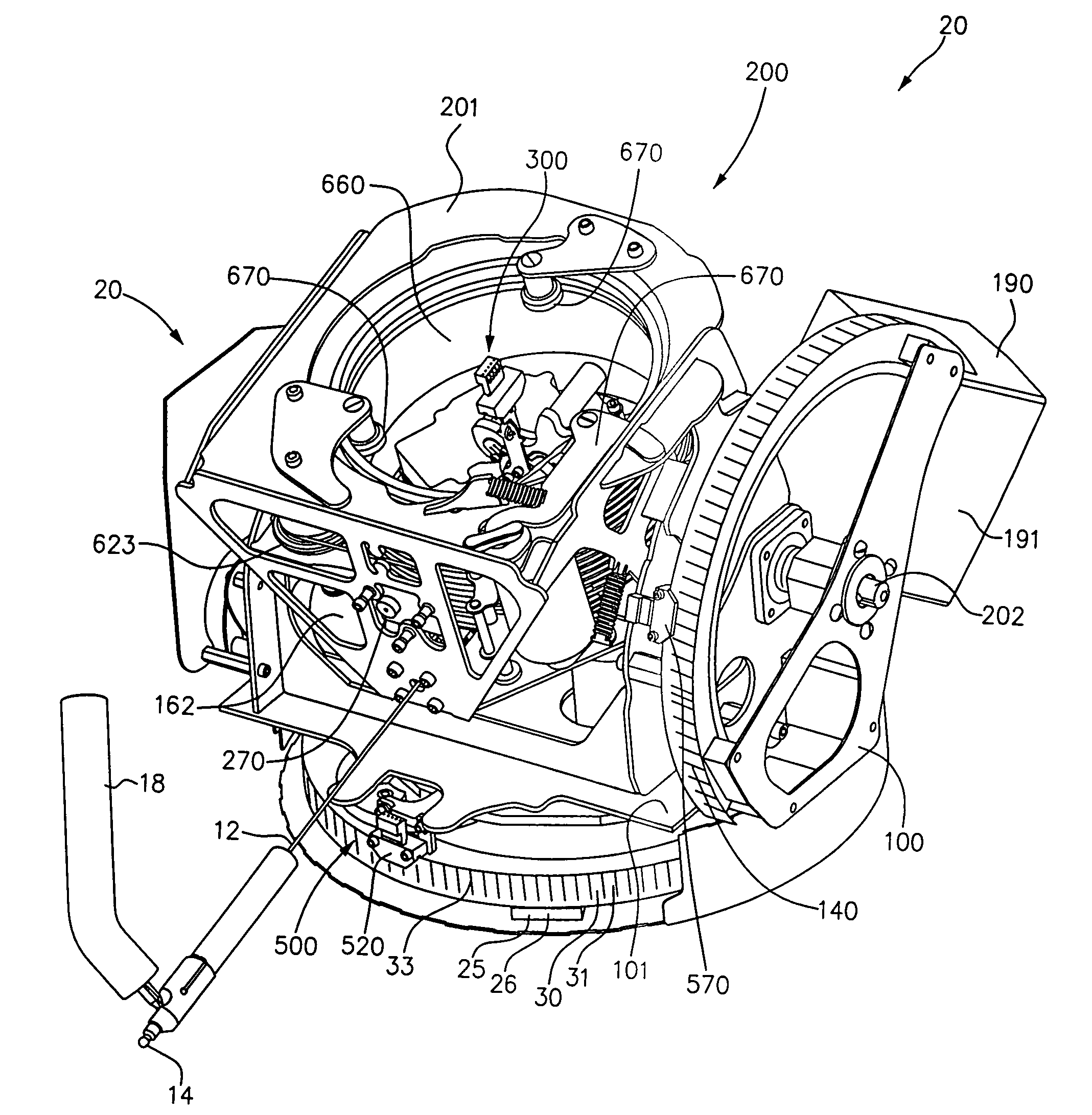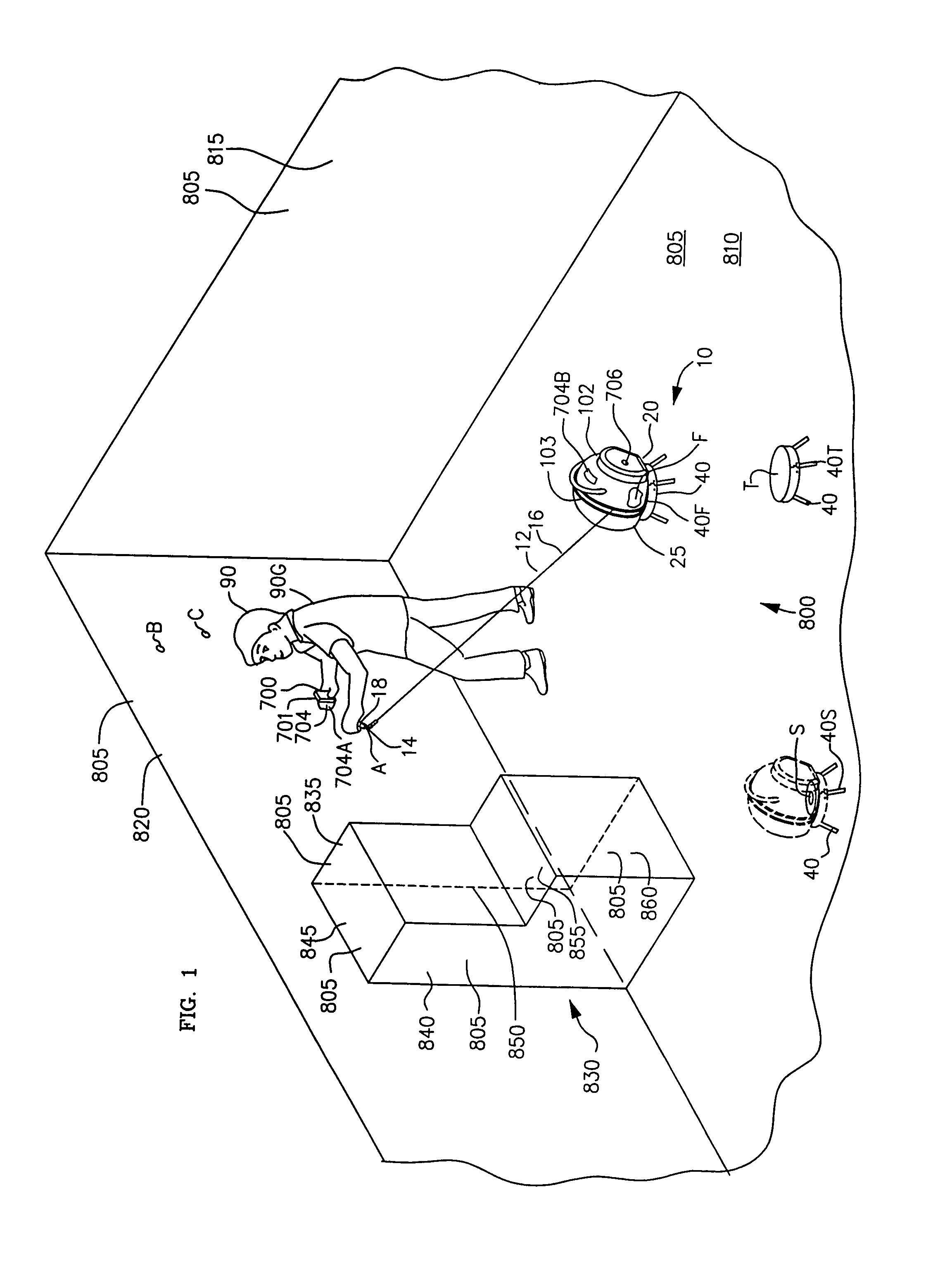Measuring device with extensible cord and method
a technology of measuring device and extensible cord, which is applied in the direction of measuring tape, mechanical measuring arrangement, instruments, etc., can solve the problems of inability to meet the needs of the user, etc., to achieve the effect of improving reducing the accuracy of the measurement, and reducing the cost of the devi
- Summary
- Abstract
- Description
- Claims
- Application Information
AI Technical Summary
Benefits of technology
Problems solved by technology
Method used
Image
Examples
second embodiment
[0089]FIG. 9 is a perspective schematic of the cable angular displacement sensor 300 in the form of proximity or contact sensors, such as contact sensors 380 mounted to frame 201. Cable 12 is shown in alignment position 305.
[0090]A first pair 380A of contact sensors 381A, 381B are equally spaced on opposite sides of cable 12 for detecting angular displacement of cable 12 about a first contact sensor axis perpendicular to a midline between first sensors 380A. A second pair 380B of contact sensors 381C, 381D are equally spaced on opposite sides of cable 12 for detecting angular displacement of cable 12 about a second contact sensor axis perpendicular to a midline between second sensors 380B. If cable 12 is angularly displaced so as to touch sensor 381A, sensor 381A produces a signal on line 308C1 indicating rotation is required about the first contact sensor axis in a first direction. If cable 12 touches sensor 381B, sensor 381B produces a signal on line 308C2 indicating rotation is r...
third embodiment
[0092]FIG. 10 is a perspective schematic of the cable angular displacement sensor 300 in the form of optical sensors 385 mounted to frame 201 for detecting movement of cable 12 from the alignment position 305. Cable 12 is shown in alignment position 305.
[0093]In the exemplary embodiment, each optical sensor 385 includes a light source 386, some focusing lenses 387, and a light sensor 388.
[0094]A pitch optical sensor 385A includes light source 386A that emits light and is disposed on one side of cable 12 and a light sensor 388A for receiving the emitted light is disposed on the other side of cable 12. Light sensor 388A may include a CCD array 389A or other light detector as is well known. One or more lenses, such as lenses 387, may be used to focus or magnify the light for accurate reading. Sensor 388A detects when the shadow of cable 12 moves up or down and produces a signal, such as on line 309D, indicative thereof for directing pitch servoed motor 162 to move pitch carriage 200 so...
fourth embodiment
[0098]FIG. 11 is a perspective schematic of the cable angular displacement sensor 300 in the form of a magnetic or electromagnetic sensor 390. A pitch electromagnetic sensor 390A detects the proximity of cable 12 and, when cable 12 moves up or down, produces a signal, such as on line 309E, indicative thereof for directing pitch servoed motor 162 to move pitch carriage 200 so as to return cable 12 to alignment position 305. A turn optical sensor 390B detects the proximity of cable 12 and, when 12 moves left or right, and produces a signal, such as on line 308E, indicative thereof for directing turn servoed motor 122 to move turn carriage 100 so as to return cable 12 to alignment position 305.
[0099]Magnetic sensors could also be used to detect the proximity of cable. In the exemplary embodiment, the output of sensors 390 corresponds directly to movement in θ and φ. However, other axes may be used and translated into movement in θ and φ.
PUM
 Login to View More
Login to View More Abstract
Description
Claims
Application Information
 Login to View More
Login to View More - R&D
- Intellectual Property
- Life Sciences
- Materials
- Tech Scout
- Unparalleled Data Quality
- Higher Quality Content
- 60% Fewer Hallucinations
Browse by: Latest US Patents, China's latest patents, Technical Efficacy Thesaurus, Application Domain, Technology Topic, Popular Technical Reports.
© 2025 PatSnap. All rights reserved.Legal|Privacy policy|Modern Slavery Act Transparency Statement|Sitemap|About US| Contact US: help@patsnap.com



